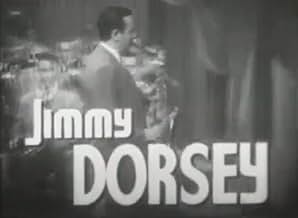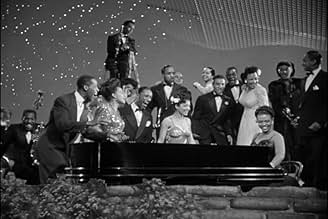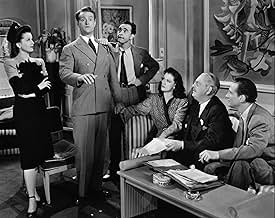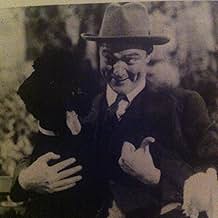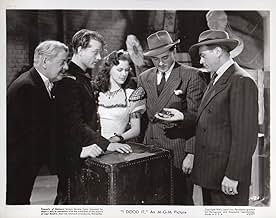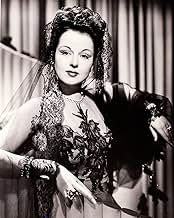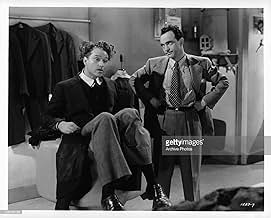CALIFICACIÓN DE IMDb
6.1/10
743
TU CALIFICACIÓN
Un torpe aparcacoches de un hotel de lujo se enamora de una estrella de Broadway. Cuando ella acepta casarse con él para fastidiar a su prometido mujeriego, se topan con saboteadores nazis.Un torpe aparcacoches de un hotel de lujo se enamora de una estrella de Broadway. Cuando ella acepta casarse con él para fastidiar a su prometido mujeriego, se topan con saboteadores nazis.Un torpe aparcacoches de un hotel de lujo se enamora de una estrella de Broadway. Cuando ella acepta casarse con él para fastidiar a su prometido mujeriego, se topan con saboteadores nazis.
- Dirección
- Guionistas
- Elenco
- Dirección
- Guionistas
- Todo el elenco y el equipo
- Producción, taquilla y más en IMDbPro
Opiniones destacadas
I hope they paid Powell triple. That rope dance she does is maybe the most demanding gauntlet of timing I've seen in years of viewing. I'm not surprised the rehearsal for it "knocked herself out cold", (IMDB). Then too, she's got the movie's comedic highpoint where Skelton has to bend her upside down and sideways while she's knocked out with sleeping pills. And catch that climactic top-like spin in front of the mock battleship that had me dizzy for a week. To me, the movie's really her showcase. On the other hand, Red's routines pick up slapstick momentum toward the end, but the first part has him do little more than wear a goofy grin. As a Skelton fan, I don't think it's the comedian's best showcase.
On the whole, the 100-minutes amounts to a rather unwieldy package, with a few over-stretched routines and an awkward Nazi subplot. But then this is 1943 and everybody's got to do their part. Note, for example, how class differences—a pants presser vs. a Broadway star—are overcome, while Blacks are presented in a non- demeaning way. It's like we've all got to pull together to defeat the Axis. And catch that last sequence where Red battles the Nazi Hodiak. Judging from the screen environs, I'll bet it was filmed in MGM's prop room with the lifts, props and catwalks all doing their part.
Overall-- as another reviewer points out—it's more a movie of parts than a whole. But some of those parts are fairly memorable. Most of all, however, hats off to the fearless Elinor Powell.
On the whole, the 100-minutes amounts to a rather unwieldy package, with a few over-stretched routines and an awkward Nazi subplot. But then this is 1943 and everybody's got to do their part. Note, for example, how class differences—a pants presser vs. a Broadway star—are overcome, while Blacks are presented in a non- demeaning way. It's like we've all got to pull together to defeat the Axis. And catch that last sequence where Red battles the Nazi Hodiak. Judging from the screen environs, I'll bet it was filmed in MGM's prop room with the lifts, props and catwalks all doing their part.
Overall-- as another reviewer points out—it's more a movie of parts than a whole. But some of those parts are fairly memorable. Most of all, however, hats off to the fearless Elinor Powell.
I generally find Red Skelton films entertaining, so I poured a glass of wine and tee'd up "I Dood It" on a quiet Sunday afternoon.
Red Skelton was his usual great. I understand that Buster Keaton was his coach for some of the slapstick, and it showed. But one genius plus one genius equals some great comedy, so that was okay with me.
However, I was really blown away by three performers I didn't know very well. Eleanor Powell was a fine actress and a fantastic dancer. Check out her lasso dance near the beginning of the film. Absolutely amazing! And then later in the film comes Hazel Scott, a phenomenal jazz pianist who I'd never heard before. Then shortly thereafter we have Lena Horne in her powerful "Jericho" number. Those scenes alone make the movie worth spending a little time on.
There were a lot of musical numbers, too many in fact, and I have to admit I fast forwarded through the more tedious of them. And the plot was -- as many people have mentioned -- disjointed and illogical. But there's enough gold in this film to make it an enjoyable, although certainly not classic, movie event.
Red Skelton was his usual great. I understand that Buster Keaton was his coach for some of the slapstick, and it showed. But one genius plus one genius equals some great comedy, so that was okay with me.
However, I was really blown away by three performers I didn't know very well. Eleanor Powell was a fine actress and a fantastic dancer. Check out her lasso dance near the beginning of the film. Absolutely amazing! And then later in the film comes Hazel Scott, a phenomenal jazz pianist who I'd never heard before. Then shortly thereafter we have Lena Horne in her powerful "Jericho" number. Those scenes alone make the movie worth spending a little time on.
There were a lot of musical numbers, too many in fact, and I have to admit I fast forwarded through the more tedious of them. And the plot was -- as many people have mentioned -- disjointed and illogical. But there's enough gold in this film to make it an enjoyable, although certainly not classic, movie event.
You have to be a die-hard RED SKELTON fan to approve of his slapstick performance in I DOOD IT, but some of his routines just fall flat. He and ELEANOR POWELL have to deal with a less than spectacular script in which he's mistaken for a wealthy man when he's actually a pants presser. The gags that follow are weak, for the most part, but occasionally some bright bits of humor do crop up along the way.
For comic timing, nothing beats the scene where Powell takes the sleep medicine by mistake and Skelton is unable to wake her up to either put her in a chair or on a bed. Her limber body provides a lot of chuckles as he struggles to get her off the floor. The timing by both is impeccable and it's one of the film's best routines.
Too bad her dance numbers aren't staged as well as that sequence which runs a little too long. They're serviceable, but that's about all.
Jimmy Dorsey and his orchestra play some nice tunes, best of which is "Star Eyes" sung by Bob Eberly and Helen O'Connell. An "audition" scene featuring Hazel Scott at the piano and Lena Horne as vocalist on "Jericho" is a lively routine that gives the film a much needed musical highlight.
But for both Skelton and Powell, this is one of their lesser efforts. Sam Levene, Thurston Hall, John Hodiak and Richard Ainley offer good support.
For comic timing, nothing beats the scene where Powell takes the sleep medicine by mistake and Skelton is unable to wake her up to either put her in a chair or on a bed. Her limber body provides a lot of chuckles as he struggles to get her off the floor. The timing by both is impeccable and it's one of the film's best routines.
Too bad her dance numbers aren't staged as well as that sequence which runs a little too long. They're serviceable, but that's about all.
Jimmy Dorsey and his orchestra play some nice tunes, best of which is "Star Eyes" sung by Bob Eberly and Helen O'Connell. An "audition" scene featuring Hazel Scott at the piano and Lena Horne as vocalist on "Jericho" is a lively routine that gives the film a much needed musical highlight.
But for both Skelton and Powell, this is one of their lesser efforts. Sam Levene, Thurston Hall, John Hodiak and Richard Ainley offer good support.
Bumbling regular guy Joseph Rivington Renolds (Red Skelton) has a crush on Broadway star Connie Shaw (Eleanor Powell) from afar. She has her wandering-eye co-star boyfriend Larry West, and rival Suretta Brenton. Out of spite and due to a misunderstanding, she marries Joe.
The kissing rivalry is a great meet-cute. The gold mine misunderstanding is less cute. The musical within the movie slows everything down with some exceptions. It is amazing to see Lena Horne perform. The comedy is a bit uneven with Red Skelton working hard to keep it going. It has some fun moments but not all the moments work.
The kissing rivalry is a great meet-cute. The gold mine misunderstanding is less cute. The musical within the movie slows everything down with some exceptions. It is amazing to see Lena Horne perform. The comedy is a bit uneven with Red Skelton working hard to keep it going. It has some fun moments but not all the moments work.
I have this notion that the thirties was a great pressure cooker for movies, during which time all sorts of experiments were tried. Out of that period came the genres we know today, plus the great invention of Noir, uniquely American.
So I've been watching lots of 30s movies, not because they are good or particularly enjoyable. But because you can see the genotype of today's movies, which is to say I can see the origins of how we all dream and mostly imagine.
Now here is an anomaly, a 30s movie made in the 40s. I can only imagine that it was to feed the war-starved theaters. It is a remake and "borrows" musical numbers from a couple films that really were made in the 30s.
It is a spliced picture, three movies combined, something that was common in the 30's.
One movie is a stage show. Simple and straightforward. Lots of variety here.
A second movie is a comedic fold: a movie where all the players are involved in some way in a play (different than the earlier mentioned performances and more like "Gone with the Wind"). Lots of physical humor here. Red Skelton's technique was to perform a comedic motion (like rolling his eyes after getting bonked) in an exaggerated fashion and then abruptly stop before it finished and look at the audience with a big grin. It was humor about humor, a not very sophisticated but an effective fold that would grow into what we have today (and call irony).
The third movie has a wartime saboteur. Because the "fold," the notion of the play within the play, is explicit here, the explosion is to blow up the theater (and somehow simultaneously threaten the nation by mechanisms unexplained).
Its a mess, these three parts not integrated in any way.
Ted's Evaluation -- 1 of 3: You can find something better to do with this part of your life.
So I've been watching lots of 30s movies, not because they are good or particularly enjoyable. But because you can see the genotype of today's movies, which is to say I can see the origins of how we all dream and mostly imagine.
Now here is an anomaly, a 30s movie made in the 40s. I can only imagine that it was to feed the war-starved theaters. It is a remake and "borrows" musical numbers from a couple films that really were made in the 30s.
It is a spliced picture, three movies combined, something that was common in the 30's.
One movie is a stage show. Simple and straightforward. Lots of variety here.
A second movie is a comedic fold: a movie where all the players are involved in some way in a play (different than the earlier mentioned performances and more like "Gone with the Wind"). Lots of physical humor here. Red Skelton's technique was to perform a comedic motion (like rolling his eyes after getting bonked) in an exaggerated fashion and then abruptly stop before it finished and look at the audience with a big grin. It was humor about humor, a not very sophisticated but an effective fold that would grow into what we have today (and call irony).
The third movie has a wartime saboteur. Because the "fold," the notion of the play within the play, is explicit here, the explosion is to blow up the theater (and somehow simultaneously threaten the nation by mechanisms unexplained).
Its a mess, these three parts not integrated in any way.
Ted's Evaluation -- 1 of 3: You can find something better to do with this part of your life.
¿Sabías que…?
- TriviaEleanor Powell reportedly knocked herself out cold during rehearsals for the lariat dance.
- Citas
Kenneth Lawlor: How's the piano, Hazel?
[Hazel runs her fingers up and down the keyboard]
Hazel Scott: I guess it'll hold up.
- Versiones alternativasThere is an Italian edition of this film on DVD, distributed by DNA srl, "THE BAND WAGON (Spettacolo di varietà, 1953) - New Widescreen Edition + IL SIGNORE IN MARSINA (1943) (Shortened Version)" (2 Films on a single DVD, with "The Band Wagon" in double version 1.33:1 and 1.78:1), re-edited with the contribution of film historian Riccardo Cusin. This version is also available for streaming on some platforms.
- ConexionesEdited from Nacida para el baile (1936)
- Bandas sonorasStar Eyes
(1943)
Lyrics by Don Raye
Music by Gene de Paul
Played Jimmy Dorsey and His Orchestra (uncredited) at a nightclub
Sung by Bob Eberly (uncredited) and Helen O'Connell (uncredited)
Danced by Red Skelton (uncredited) and Eleanor Powell (uncredited)
Played as background music often
Selecciones populares
Inicia sesión para calificar y agrega a la lista de videos para obtener recomendaciones personalizadas
- How long is I Dood It?Con tecnología de Alexa
Detalles
- Tiempo de ejecución
- 1h 42min(102 min)
- Color
- Relación de aspecto
- 1.37 : 1
Contribuir a esta página
Sugiere una edición o agrega el contenido que falta


